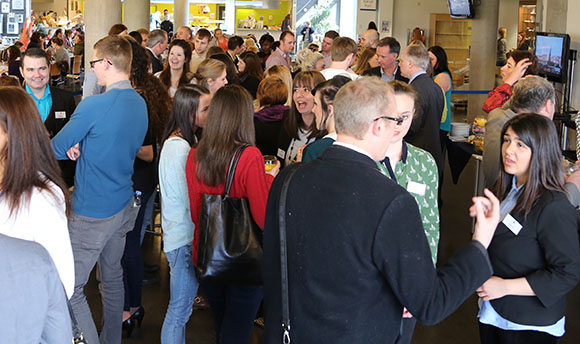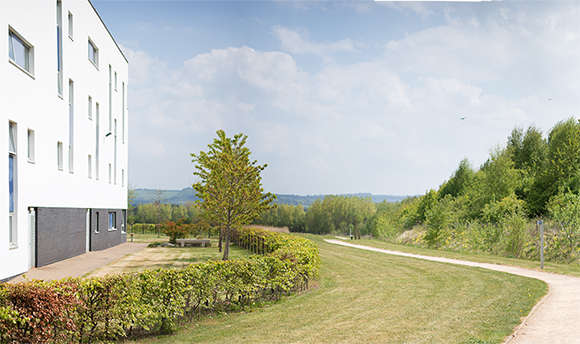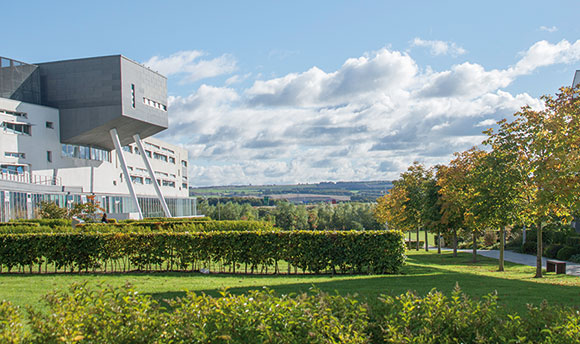‘Wee Forest’ is planted on campus
Local school children and university students and academics will gather at Queen Margaret University on 24th and 25th February to plant a ‘Wee Forest’.
The Wee Forest at Queen Margaret University (QMU) is part of a £500K Scottish Government funded project, led by NatureScot, which will see schools and local communities planting 20 Wee Forests across the country this winter.
A Wee Forest is a tennis court-sized area where people can create dense planting of fast growing native woodland. It often incorporates an outdoor classroom where young learners and the local community can come together to connect with nature and tackle the ecological and climate emergency by planting and looking after their own tiny area of forest.
The community event, which will give young people and students the chance to plant trees in their own neighbourhood, is the first part of a bigger plan to create an outdoor learning hub in the grounds of the University. The Hub will provide access to different environments for learning activity, wellbeing, community engagement and professional development, and will become a central point of learning for QMU students, the local community and the wider teaching profession.
The planting of the Wee Forest will see the first spade in the ground as the University team progresses swiftly with its wider plans to transform areas of the gardens which will support outdoor learning activity. The development of the Wee Forest is the perfect start to the project as it will help the land around the campus become nature-rich and more resilient to climate change. It also provides students, school children and local residents with the opportunity to help tackle the climate emergency and contribute to Scotland’s tree planting targets.
Patrick Boxall, Lecturer in Initial Teacher Education at Queen Margaret University, is leading the development of the University’s outdoor learning hub. He explained:
We are starting off the way we want to continue - by involving the local community in a learning project that grounds people in nature. It's the perfect opportunity for school children to get their hands dirty, get involved outdoors and learn about how to plant a Wee Forest. It’s something tangible that everyone can connect with, take some ownership of the space and create a positive association with the University and the development of the hub.
Patrick continued: “Throughout the pandemic, we have seen how we all benefit mentally and physically by connecting with nature, so getting people involved in the creation of the first Wee Forest in East Lothian can only be a good thing.”
Over the next few months, plans turn into reality with work leading on from the Wee Forest to the creation of various outdoor spaces across the campus.
Patrick Boxall confirmed: “Planting the Wee Forest gives the school children and the community a feel for what is coming next. In March, the creation of a trail and shelter will begin, and we have ideas for a sensory garden, art, storytelling, performances and spaces which will support health and wellbeing, so it’s exciting to see the hub starting to take shape.”
Dr Olivia Sagan, Head of Division of Psychology, Sociology & Education at Queen Margaret University, said: “We owe it to our emerging generations to equip them with the knowledge they need to understand, enjoy and protect the natural world. But to do that, we need to equip the teaching profession with the skills to support young people in meaningful interactions with nature. That’s why we have invited schools to be part of the Wee Forest planting, and why we are embedding outdoor learning in the University’s teacher education courses at both undergraduate level on our BA (Hons) Education Studies (Primary), and at postgraduate level on our PGDE Secondary (Home Economics). We are delighted to now extend this commitment to outdoor learning with the creation of the Wee Forest as part of our developing outdoor learning hub.”
Charlie Cumming, Chief Executive, Edinburgh & Lothians Greenspace Trust, said:
We are delighted to be a local delivery partner for the Wee Forest project. The creation of the Wee Forest is very important for people and wildlife, particularly with it being in an urban environment. It will enable people to engage with nature on their doorstep and inspire young people to take an active interest in their local environment.
Karen Morrison, Wee Forests Project Officer at NatureScot, said:
Wee Forests are not only a great way to help people connect with nature closer to home, they also can inspire the next generation to care for it. We’re delighted to see young people and the local community coming together to get this Wee Forest underway and we hope that over the years it will be the source of much enjoyment, learning and inspiration. As well as the many benefits for people, projects like this are also giving communities an important opportunity to help restore nature and tackle climate change by contributing to Scotland’s tree planting targets.
Dr Sagan concluded: “We are grateful to NatureScot, the Scottish Government and Edinburgh & Lothians Greenspace Trust for their guidance and hard work in creating the Wee Forest, and to our partners who share our vision for an outdoor facility which will enrich our teaching curriculum, enhance our student experience, and support the delivery of outdoor learning qualifications for Scotland’s teaching profession. Above all else, we look forward to helping young people develop a love of nature and an understanding of its vital role in our wellbeing.”
NatureScot is leading the roll out of Wee Forests in Scotland and is administering a Wee Forest Demonstration Project. This £500K project, planting 20 Wee Forests in 2021/22, creates small woodlands in urban areas. It aims to improve local biodiversity and help tackle the impacts of climate change; as well as providing opportunities for people living in local communities across Scotland to connect with nature. Wee Forests can incorporate an outdoor classroom and will provide opportunities for school and community engagement and long-term citizen science.
Supported by Earthwatch Europe, schools and local people will take part in citizen science activities to raise awareness of climate change and the value of urban trees. This will include monitoring the butterflies that use the forests, calculating the amount of carbon captured and measuring the impact that trees have on slowing down the run-off from rainstorms.
NatureScot is funded by The Scottish Government and is the NatureScot is the lead agency in the development of the Wee Forests in Scotland. NatureScot is the operating name of Scottish Natural Heritage.
Wee Forests: Part of the TinyForest Global Family
Further information about Tiny Forests and climate change can be found on the Earthwatch website.
Queen Margaret University, Edinburgh
For further information about Queen Margaret University’s initial teacher education courses visit: BA Hons Education Studies (Primary) and PGDR Secondary (Home Economics).
For further media information contact Lynne Russell, Communications Manager, Queen Margaret University, Edinburgh, E: lrussell@qmu.ac.uk; M: 07711 011239.



